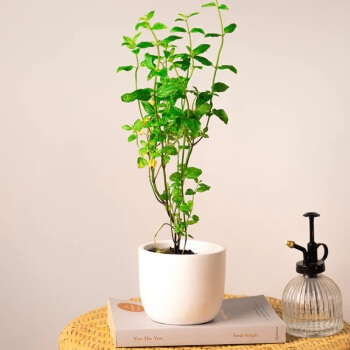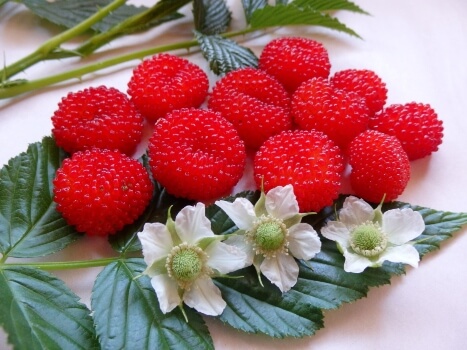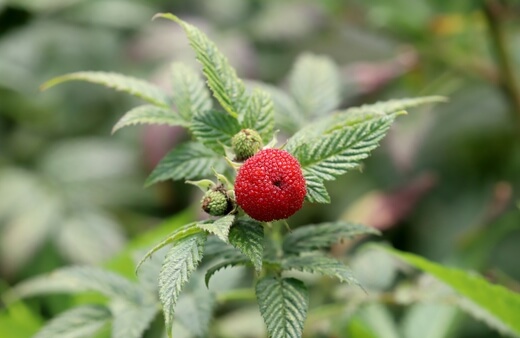Picking raspberries fresh off the bush is one of life’s greatest pleasures. All the delicious things you can make with these delightful fruits are another. In our how to grow and care guide, we’ll introduce you to the Atherton raspberry in more detail.
You’ll have a chance to read about how to propagate this shrub from cuttings or division, how to care for your native raspberry, bush tucker info, pests and diseases, and some frequently asked questions about this Australian native.
More...

Family: | Rosaceae |
|---|---|
Genus: | Rubus |
Species: | R. probus |
Common Names: | Native raspberry, Atherton raspberry, Bush raspberry |
Location: | Outdoor |
Type: | Shrub |
Growth: | Up to 2 metres tall and wide |
Sun requirements: | Full sun, part shade |
Foliage Colour: | Green |
Flower Colour: | White |
Flowering: | Spring |
Fruit: | Spring, summer |
Maintenance level: | Average |
Poisonous for pets: | No |
Introducing Atherton Raspberry
Atherton raspberry, native raspberry, or bush raspberry, is of the tropical variety. It is native to Australia and Papua New Guinea. This kind of raspberry likes the warmer climate and is a much loved bush tucker fruit.
You will recognize the Atherton raspberry for its bright red berries. They are a bit bigger than traditional raspberries and have a more mild flavour. Native raspberry can be eaten fresh but tastes just as good in a cake or as a jam or sauce.
The Atherton raspberry produces its fruit in summer and autumn but in some parts of Australia, it might in fact give you fruit all year round. You’ll know the fruit is ripe when it falls off the shrub at the touch of your hand.
Native raspberries grow enthusiastically and aren't afraid to take over your garden. The shrub will grow well in a pot and helps to keep it contained.
Growing Atherton Raspberry
Native raspberries like a loamy and well-draining soil and full sun if possible for best results. Size wise, you’re looking at a plant that grows up to 2 metres tall and 2 metres wide. It will happily grow on a trellis if you like. The shrub is also drought tolerant.

Source: IndigiGrow
Propagating Native Raspberry
Bush raspberry Propagation from Cuttings
Atherton raspberries can easily be grown from cuttings and the best time to do this is at the end of winter. Take a cutting that is about 20 centimetres in length and cut the end which will be placed in the ground at an angle.
We recommend dipping the cutting into rooting hormone before planting in the ground. As a guideline, two thirds of the cutting should be below the soil. By springtime, you should have some roots and shoots on your cutting.
Propagating Atherton Raspberry by Division
Another simple way to propagate native raspberry is by using the process of division. The start of the spring is perfect for this when suckers emerge from the parent plant and can be dug up and cut free.
These suckers have a horizontal stem that would have connected them to the main plant and have a root system of their own. You can then transplant these.
Best Conditions for Growing Atherton Raspberry
Climate
The bush raspberry doesn’t like frost so be sure to protect your plant accordingly if you live somewhere with a cold climate.


Get Your Free Guide:
Master Growing Australian Natives eBook
A Must Have Complete Guide for Every Australian Garden
Get Your Free Guide:
Master Growing Australian Natives eBook
A Must Have Complete Guide for Every Australian Garden
Sunlight
The native raspberry does its best growing in full sun but doesn’t mind part shade too. It just means the shrub will then produce less fruit. What the Atherton raspberry doesn’t like is a hot and direct afternoon sun and also a hot wind.
This kind of exposure will burn the leaves and the fruits will ripen too quickly. You’re aiming for a location that has full sun in the morning and middle of the day, and then more shade for the afternoon.

Source: Melbourne Bushfood
Watering Schedule
Since Atherton raspberry is tropical, it should be watered well when the temperatures are higher and in winter you can cut back on the watering. The native raspberry actually wilts when it’s thirsty so you’ll then know to water it.
The plant has a shallow root system which explains the need for regular water in spring and summer. A great way to lock in moisture is by mulching around the plants. It also keeps the roots cool when the weather is hot and keeps weeds away.
What Soil to Use
The Atherton raspberry needs a moist and well-draining soil. In terms of pH, you can aim for acidic to neutral, so 5.6 to 6.2. They also like lots of organic matter.
Before you plant your bush raspberry, we recommend digging lots of manure into the soil, and adding compost. The compost improves soil drainage. Just be mindful that Atherton raspberries don't like heavy clay soil.
Fertiliser
The native raspberry produces lots and lots of fruit and therefore needs to be fed often. Fertilising the shrub with an organic compost in August, which is the start of the growing season, also helps with fruiting.
The Atherton raspberry should ideally be fertilised at the beginning of spring and autumn using a general purpose and slow release fertiliser. A pellet kind is preferable over a liquid option.
You can also use blood and bone to provide the native raspberry with nitrogen and phosphorus.
Pruning Atherton Raspberry
Your Atherton raspberry can be pruned once a year after the fruiting season which is around July. Be sure to remove older stems to make way for the new growth and if you want to manage the shrub’s spread, you’ll need to remove any side suckers on the plant.
If you’re looking for the right tools to get the job done, check out our gardening tools and products section.
Atherton Raspberry Bush Tucker

Source: Daleys Fruit Tree Nursery
The native raspberry can be enjoyed raw and fresh from the plant. They are also popular choices for baked goods, syrups and sauces, as well as jams. Atherton raspberries can be frozen, added to yoghurt, cereal or salads, and even used to make cocktails.
It’s worth knowing that the berries sometimes turn a brilliant bright red colour before they are actually ripe so you’ll need to wait until they fall off the plant easily when touched. That means they will be at their most tasty.
The leaves of the native raspberry are astringent and can be used to get rid of toxins in the body. The fruit is also known to be good for the heart. Raspberry leaf tea is recommended for pregnant women three to four months before giving birth and assists with birth pains.
The cooled native raspberry tea is a known cure for conjunctivitis when applied to the eye. Atherton raspberry leaf tea is great to treat a sore throat as it reduces inflammation.
Have a look at our other growing guides for more Australian bush tucker information and inspiration.Common Native Raspberry Pests and Diseases
Botrytis Fruit Rot
When the berries start to ripen, you might notice a watery looking rot and it’s usually a golden sort of colour. When humidity is high, the fungal spores grow on these water spots.
The best way to manage the disease is to improve air circulation for your native raspberry, prune as needed and make sure you’re not giving the shrub too much nitrogen. Ideally you should harvest the fruit often.
Powdery Mildew
You’ll notice a powdery white growth on the underneath of your bush raspberry leaves. It might also be on the fruit of the shrub. New plant growth might look distorted and you might see dieback happening.
The berries don’t reach their mature size and they might wither and die. This disease tends to happen in dry weather and when there isn’t good air circulation. You can prune off the diseased parts of the native raspberry plant accordingly and ensure there is good spacing.
Root Rot
You might see that the leaves of your Atherton raspberry are unusually small, that they start to discolour or wilt. Fruit growth will be stunted, and the roots of the shrub will be almost black.
The discolouration spreads all the way to the crown of the plant. You’ll need to get rid of and destroy the parts of the plant that are infected, and be sure that your soil is sufficiently well-draining.
Atherton Raspberry Frequently Asked Questions

What is the best way to increase the amount of fruit that the bush raspberry produces?
This really comes down to sun exposure as the more sun the plant gets, the more fruit it produces. Good air circulation is important, and the plant mustn’t stand in water but also mustn’t dry out.
How long will it take for my Atherton raspberry to produce fruit?
This usually happens in the first year. If you notice that your native raspberry seems delayed in producing fruit, try to move it to a spot with more sun and add a bit of potash to the soil.
The potash helps if there is too much nitrogen in the soil which can affect fruit production.
What do I need to know about growing Atherton raspberries in a pot?
The native raspberry will need a trellis to grow on in order to keep it upright when planted in a pot. You need to find somewhere sunny on a balcony or patio, and if the leaves look yellow or wilted, you could be over or under watering the plant.
When you plant your bush raspberry in a pot, be sure to use a good quality potting mix and then add your own plant food.
What is the best kind of fertiliser for the native raspberry?
The right type of fertiliser should have plenty or nitrogen, but you are aiming for a balanced kind of fertiliser. We recommend a 10-10-10 fertiliser.
How can I make sure that my Atherton raspberry grows happily?
This really comes down to the soil as the shrub likes a very fertile soil that needs to be well-draining and slightly acidic.
If you find that you’re dealing with soil that isn’t great you can just add some organic matter. If you can plant your native raspberry in a raised garden bed, this helps with drainage.
Can the Atherton raspberry produce fruit twice a year?
Raspberries come in two different kinds. There is an ever-bearing kind that produces fruit twice a year. This happens in summer and in autumn. The second kind is a summer bearing variety and this is just once a year.
Looking for more gardening advice and support? Sign up for our newsletter for everything from tool reviews, to plant profiles.
Wrapping Up Our Atherton Raspberry Growing and Care Guide
The Atherton raspberry is a charming and delightful choice for the Australian garden. It doesn’t need a lot of maintenance, can be easily propagated, and the use of the fruits and leaves are fantastic for ailments and delicious treats. We’re giving the native raspberry our green thumbs up!
Published on December 24, 2022 by Gary Clarke
Last Updated on December 5, 2024





Hi, from I am reading here, I don`t have to cut back the raspberry plant to the ground after fruiting finishes. I have been told that summer fruiting raspberry (Heritage variety) have to be all cut flush with the ground. Autumn fruiting raspberry (Tullameen variety) you cut back the stems that have just fruited and leave the new stems for next year`s fruit. Is this correct?
Hi John,
The traditional pruning methods for raspberries still work, but because Atherton raspberries fruit for a longer season than most, they need slightly different care.
The easiest way to prune them is to mark unproductive stems and cut them out at the start of the season in spring (just tie a piece or coloured string round anything that’s not producing much in summer so you know which to take out later).
You can cut back to the ground immediately after fruiting like the article suggested, but it’s best to wait until spring on these hard-to-classify raspberries.
Best regards,
Gary Clarke
You said fruiting is in Spring and summer, then say to cut back 'after fruiting season which is in July'. July is mid winter. Even if what you meant to say was the time to cut back is July, that is still too far after summer. Wouldn't autumn be the time to cut back, from March to May? Or is winter the best time and if it is, why not just say that?